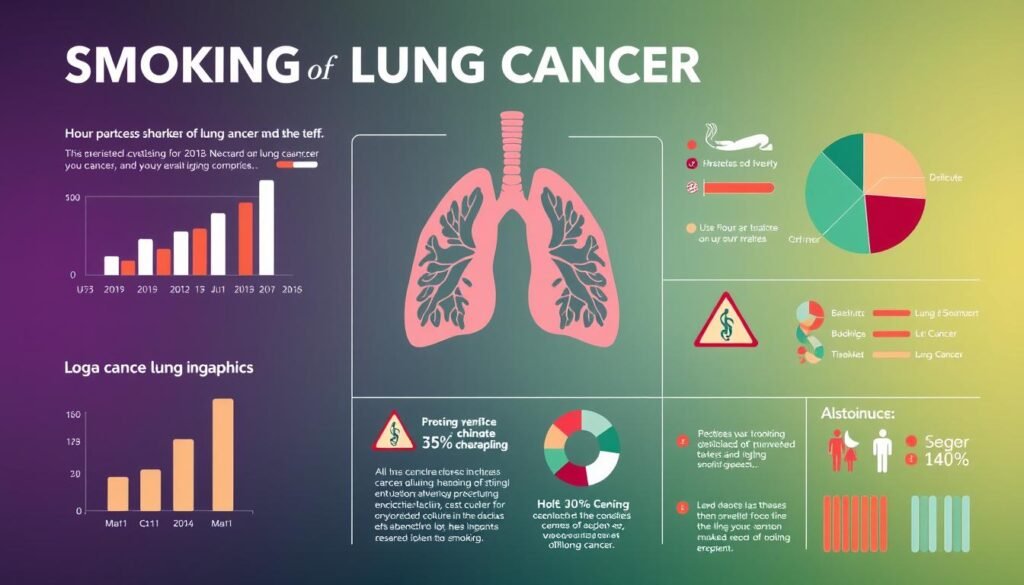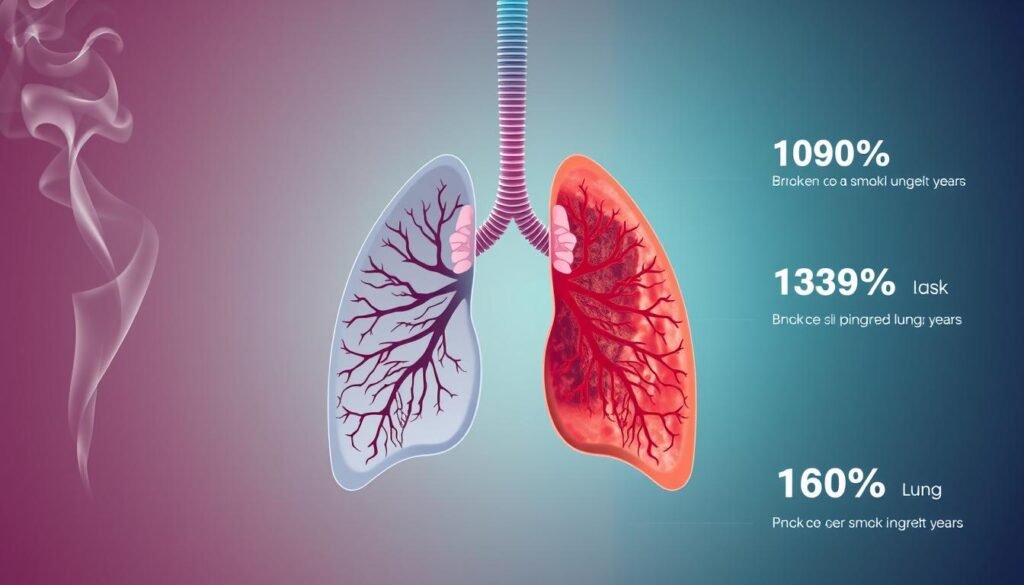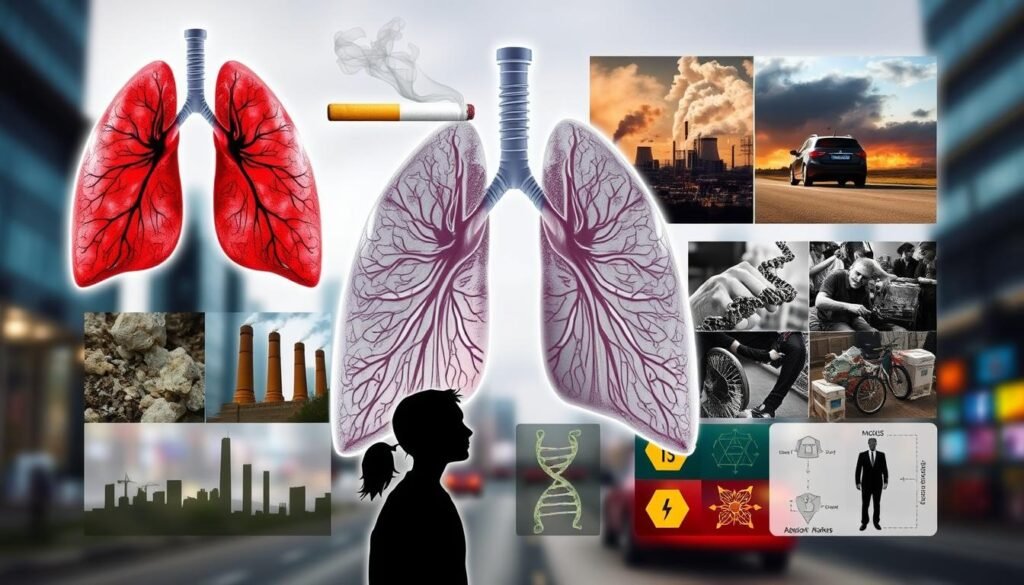Did you know that 85% of lung cancer cases in the U.S. are due to smoking? This fact highlights the need to understand pack years. Pack years measure tobacco exposure by looking at how often and how long people smoke. Studies show that how long someone has smoked matters more for lung cancer risk than how many cigarettes they smoke daily. So, knowing a person’s smoking history in pack years is crucial for lung cancer screening. It helps in making health policies and efforts to stop smoking to lower risks.
This article explores the complex topic of pack years and what they mean for lung health. It shows how correctly measuring pack years can guide doctors and public health policies.
Key Takeaways
- Pack years combine the intensity and duration of smoking to assess lung cancer risk.
- The duration of smoking is often more critical than the number of cigarettes smoked each day.
- Effective tobacco cessation can significantly lower lung cancer risk.
- Assessment of pack years is essential for accurate lung cancer screening.
- Understanding smoking duration can lead to improved healthcare interventions.
- Research supports the importance of evaluating both pack years and smoking history for better outcomes.
What Are Pack Years?
Pack years help us understand someone’s smoking history and its effect on lung cancer risk. It combines packs smoked per day with how many years someone smoked. This way, doctors get a better idea of someone’s health risk than just knowing how long they smoked.
Definition and Calculation of Pack Years
If a person smokes one pack a day for 20 years, they have 20 pack years. But smoking half a pack daily for 30 years equals 15 pack years. This helps doctors see how smoking affects lung health over time.
Formula for Determining Pack Years
Here’s the formula for calculating pack years:
- Number of packs smoked per day x Number of years smoked
We use this formula to connect smoking history with lung cancer risk. For example:
| Smoking Habit | Packs per Day | Years Smoked | Pack Years |
|---|---|---|---|
| One pack a day | 1 | 20 | 20 |
| Two packs a day | 2 | 30 | 60 |
| Half a pack a day | 0.5 | 30 | 15 |
Real-world Examples of Pack Year Calculations
Through real examples, we see how pack years affect lung cancer risk. Around 70% of stage IIIB/IV Non-Small Cell Lung Cancer patients smoked over 15 pack years. On the other hand, 13% of smokers had 15 or fewer pack years. This shows survival rates can vary based on smoking history. People with less than 15 pack years tend to live longer than those who smoked more.
https://www.youtube.com/watch?v=QDDnYcn-o8I
The Link Between Smoking and Lung Cancer
Smoking greatly increases the risk of lung cancer, which is the top cause of cancer deaths in the U.S. About 85% of lung cancer cases are due to smoking. An estimated 125,070 Americans might die from lung cancer in 2024. It’s crucial we tackle this public health issue.
Statistics on Smoking as a Leading Cause of Lung Cancer
The link between smoking and lung cancer death rates is clear. Research shows a strong link between smoking and lung cancer. For smokers, the odds of getting lung cancer are much higher, 7.82 for men and 11.76 for women. These numbers highlight the urgent need for programs to help people quit smoking.
How Smoking Affects Long-term Health
Smoking’s harmful effects go way beyond lung cancer. It also leads to heart disease and other kinds of cancer. Knowing the dangers of smoking is key to fighting lung cancer. By teaching people about these risks, we can reduce smoking rates and improve health.

Number of Pack Years and How They Influence Lung Cancer Risk
The link between pack years and lung cancer risk is clear. Studies show the more you smoke, the higher your risk of lung cancer. This shows how smoking over time greatly affects lung cancer risk.
Understanding the Risk Correlation
Current smokers see lung cancer rates of 1.97 per 1000 person-years. This is higher than 1.61 in ex-smokers and 0.26 in those who’ve never smoked. Even those who smoked for less than five years face a risk 12 times higher than non-smokers.
The Role of Smoking Intensity and Duration
The amount and time of smoking both matter in risk assessment. Those who smoke more daily are at highest risk. Women face lung cancer risks sooner than men, likely due to biological differences. Also, having COPD adds to the risk, making regular checks and detailed histories crucial.

Lung Cancer Risk Factors Beyond Pack Years
Understanding lung cancer goes beyond just knowing about smoking. Many elements add to the risk of this disease. It’s important to know other risks that play a part in lung cancer.
Other Contributing Factors to Lung Cancer Risk
Smoking isn’t the only thing that increases lung cancer risk. Genes, the environment, and harmful substances also matter. Some main risks are:
- Exposure to radon, the second-leading cause of lung cancer in the U.S.
- Working with asbestos, which, together with smoking, boosts lung cancer risk.
- Exposure to dangerous chemicals like arsenic, or diesel exhaust.
- Having a family or personal history of lung cancer greatly raises the risk.
Learn more about these causes at this resource.
The Impact of Secondhand Smoke Exposure
Secondhand smoke is a big risk for those who don’t smoke. It’s the third leading cause of lung cancer in the U.S. Being around smoke often increases your lung cancer risk.
Understanding how all these factors link to lung cancer is crucial. For more information, visit this guide.

The Importance of Tobacco Cessation
Stopping tobacco use is key to better health. It sharply lowers lung cancer and other disease risks. The perks of quitting smoking show up fast and grow over time. Quitting tobacco brings both instant and long-lasting benefits against diseases.
Health Benefits of Quitting Smoking
Right after quitting, the body starts to repair itself. The first good changes include:
- Heart rate and blood pressure go back to normal
- Lower carbon monoxide levels in the blood
- Better blood flow
- Less risk of lung cancer and heart problems
Long-term benefits are just as important. Not smoking for a while greatly lowers lung cancer risk. Those who quit smoking cut their lung cancer risk much more than those who keep smoking.
How Pack Years Affect Cessation Outcomes
How much you’ve smoked affects quitting results. A study showed that smokers with under 30 pack years had a big drop in lung cancer risk by cutting down or quitting. Quitters and reducers had lower risk compared to those who kept smoking, showing quitting’s benefits.
Lung cancer risk drops as smoking decreases. Data shows 76% got health screenings, stressing the need for stop-smoking programs that consider smoking history.
| Smoking Status | Adjusted Hazard Ratio (HR) | Confidence Interval (95% CI) |
|---|---|---|
| Sustainers | 1.00 (Reference) | N/A |
| Reducers | 0.74 | 0.56–0.98 |
| Quitters | 0.78 | 0.64–0.96 |
Knowing how pack years impact quitting can guide creating effective support for quitters. Custom stop-smoking programs can lead to better health and lower lung cancer risks.
Screening Guidelines for Lung Cancer
Screening guidelines for lung cancer are key in finding and treating it early. These rules are changing to help more people, especially if they’ve smoked a lot. This way, more folks have a chance to catch lung cancer early.
Criteria for Eligibility Based on Pack Years
Now, people between 50 and 80 who’ve smoked for 20 or more pack years should get checked every year. They use a special scan called low-dose computed tomography (LDCT) for this. Even if you’ve quit smoking within the last 15 years, you still qualify if you meet the pack-year requirement.
Updates to Lung Cancer Screening Recommendations
The rules used to be for people aged 55 to 74. But now, thanks to new guidelines, almost 5 million more people can get screened every year. It’s also important for doctors and patients to talk and decide together, especially for those at higher risk. Still, not many people are getting screened—only about 14.4% of those who should, based on the old rules.
Understanding Carcinogen Exposure
Tobacco products are harmful because they contain many carcinogens. These carcinogens raise the risk of lung cancer. Cigarette smoke has more than 60 carcinogens like polycyclic aromatic hydrocarbons (PAHs) and N-nitrosamines. Knowing about these carcinogens helps us understand the health risks of smoking.
Different Carcinogens in Tobacco Products
There are several types of carcinogens in tobacco products:
- Polycyclic aromatic hydrocarbons (PAHs) – They are made when organic material burns incompletely, leading to lung cancer.
- N-nitrosamines – These are very powerful carcinogens found a lot in smokeless tobacco.
- Aromatic amines – They can cause many cancers by damaging DNA.
- Volatile organic compounds – Being exposed to these can cause breathing problems and other health issues.
- Metals – Tobacco has metals like cadmium, which are linked to many cancers.
How Carcinogen Exposure Varies by Smoking Habits
How much you’re exposed to carcinogens varies based on smoking habits. Factors include:
- Duration of smoking – Smoking longer increases exposure to harmful carcinogens.
- Frequency of smoking – Smoking every day increases the level of carcinogens over time.
- Type of tobacco used – Different tobacco products have different carcinogen levels, affecting risk.
It’s important to know that all tobacco products have carcinogens, which are risky for everyone. By understanding these facts, people can make better choices about smoking and quitting.
Current Research on Lung Cancer and Smoking
Current studies focus on how smoking influences lung cancer risk. This includes how many years people smoke. Identifying risk groups can help with prevention. Another key finding is that pack years are essential in determining risk.
Recent Studies on Pack Years and Lung Cancer Risk
Recent research notes big differences in pack years across groups. For example, African American smokers with lung cancer had about 25.8 pack years. In contrast, white smokers had near 48.0 pack years. This shows the need for unique screening methods. It also points out how age and smoking habits affect lung cancer.
These insights may change who gets screened for lung cancer.
Comparative Analysis of Pack Years in Varying Demographics
African American smokers are often younger when they get lung cancer, usually around 59. White smokers are typically around 64. Despite smoking less, more African Americans are still smoking. This indicates a need for better health programs in communities.
Money issues also affect who can get screened. The latest findings on pack years should guide public health tactics. This could improve early cancer detection in various groups. For additional information on smoking and cancer risk, visit this resource.
Conclusion
Pack years are key in assessing lung cancer risk by looking at smoking habits over time. Knowing this helps with wise health choices and better lung cancer screening. With over 4,038 lung cancer cases found in a huge study, the fight against tobacco is crucial.
Studies show that bad lung function links to more lung cancer cases. People with certain lung conditions who smoke face even higher risks. This highlights the big lifesaving benefits of stopping smoking.
Experts and health groups must keep up with the latest research to fight lung cancer better. Working together to fight tobacco use can greatly reduce lung cancer’s impact. Understanding pack years and its risks is a big step towards better health and longer lives.